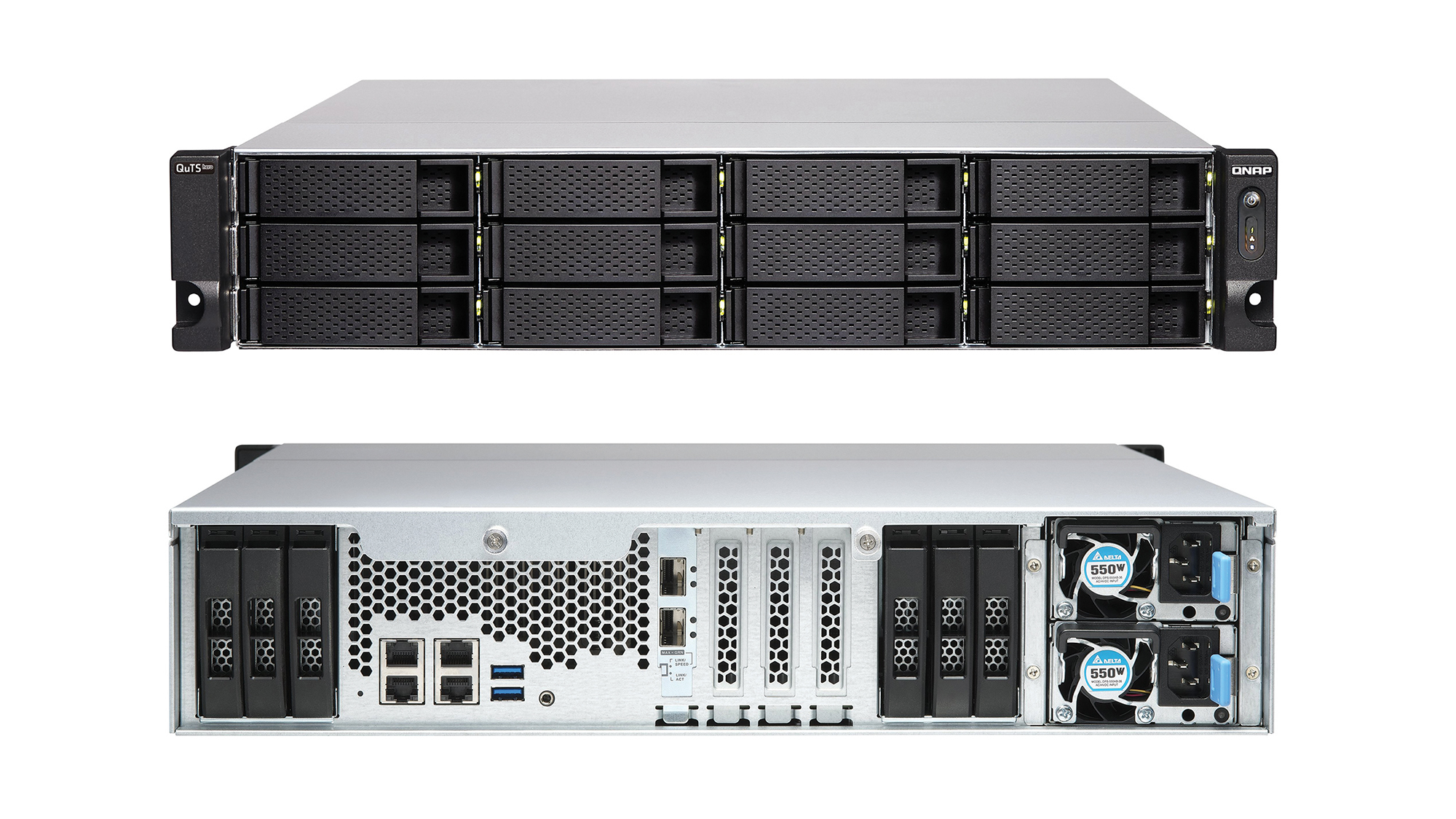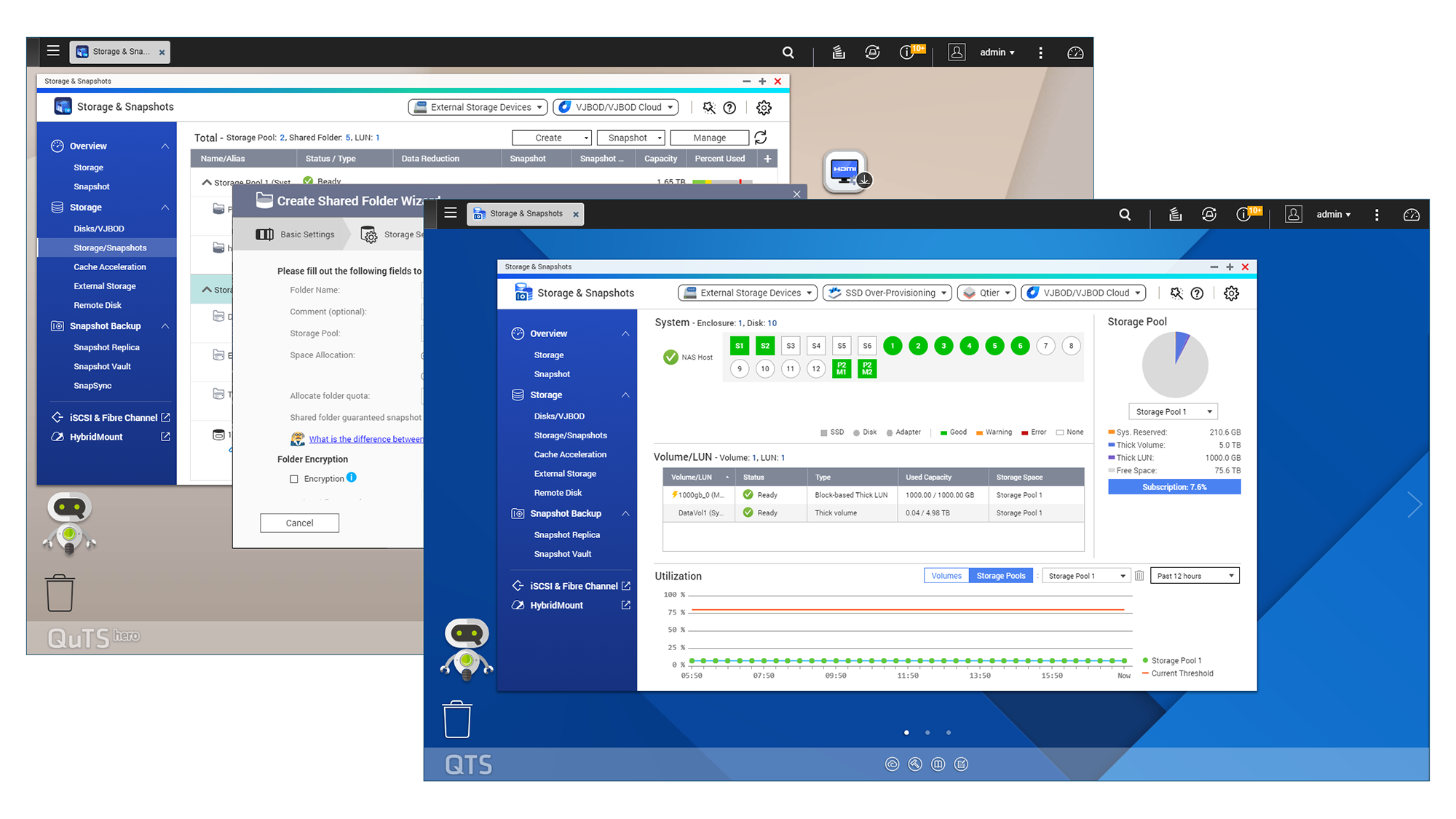Qnap TS-h1886XU-RP review: Split personality
This flexible yet affordable rack NAS boasts dual OS support, great performance and heaps of features


-
+
Fabulous performance
-
+
Highly expandable
-
+
Extremely versatile
-
-
4TB SSD cache requires 128GB RAM
-
-
Switching from QuTS hero to QTS can be laborious

If versatility is what you’re after in a business NAS, then Qnap’s TS-h1886XU-RP has you covered. This 2U rack system can house up to 18 drives, via 12 front-facing hot-swap bays and six rear SFF bays, and has plenty of connectivity options, in the form of quad Gigabit Ethernet ports plus dual 10GbE connectors.
The appliance even offers two operating systems: on initial setup, the quick-start wizard prompts you to choose between Qnap’s nimble QTS OS and the advanced QuTS hero OS. While the latter is more demanding, the TS-h1886XU-RP has the resources to match it: the price above includes 32GB of DDR4 RAM, which is enough to fully enable inline deduplication and get top performance from the 10GbE ports. The only catch is that you’re limited to a 1TB SSD cache; to increase this to 4TB, you’ll need to upgrade to the maximum 128GB.
QTS doesn’t have all the high-end features of QuTS, but it can support a 4TB cache out of the box – and, unlike QuTS, it supports Qnap’s Qtier 2 data-migration feature.
Whichever path you choose, the user experience is very similar. The two systems present almost identical web consoles, with 130 downloadable apps for QTS and 144 for QuTS. All the key backup apps are available for both OSes, including Hybrid Backup Sync 3, Qsync Central and HybridMount – plus Hyper Data Protector for VMware and Hyper-V systems.
What’s more, both platforms give excellent performance. The appliance is driven by a quad-core 2.6GHz Intel Xeon D-1622 CPU, and three vacant PCI-E slots offer plenty of expansion options: they’ll take multi-Gigabit, 10GbE, 25GbE and 40GbE network adapters, or 16/32Gbits/sec Fibre Channel cards.

Qnap recommends installing QuTS on SSDs, so for testing we used a pair of mirrored 960GB Micron SFF SSDs. For data-storage duties, we fitted six Toshiba 18TB MG09 SATA hard disks and created a massive 79TB RAID5 storage pool. Subsequently switching to QTS was a bit of an operation, as it requires you to back up all your data and reinitialise the appliance. However, QTS doesn’t require SSDs for its system pool, so we just created a single pool from the Toshiba drives - and the results were illuminating.
For 10GbE NAS performance, there’s nothing to choose between the two operating systems: under both systems, Iometer recorded read and write rates a shade over 9Gbits/sec, which is what we’d expect from a business-class appliance.
It was the same story in our file-copying tests: when we dragged a 25GB file to and from a network share, both OSes averaged around 7.6Gbits/sec for both reads and writes, while our 22.4GB test folder was copied at a speedy 2.4Gbits/sec.
To test IP SANs, we used a 1TB iSCSI target mapped to our test server over a dual 10GbE MPIO link. Again, QTS and QuTS delivered near-identical performance, with sequential read and write speeds between 17Gbits/sec and 18Gbits/sec. Moving to random read operations saw respective speeds of 18.5Gbits/sec and 18.1Gbits/sec.
We did see one big difference, however. QuTS uses Qnap’s ARC (adaptive read cache) and ZIL (ZFS intent log) features, which enable much faster random writes over iSCSI: QTS achieved rates of only 0.6Gbits/sec, while QuTS shot ahead at an average of 17.3Gbits/sec. Adding a dual SSD cache to QTS improved performance, but only to 4Gbits/sec.
Note, too, that QuTS supports triple mirroring and RAID-TP (triple parity) to protect against three drive failures – something QTS can’t match. And when creating NAS shares, QuTS gives you the option to enable native compression and deduplication to save space, plus WORM policies to prevent data being tampered with.
With its dual personality, the Qnap’s TS-h1886XU-RP will appeal to a wide range of businesses. Both OS options perform well and offer a wide range of features, and its clever 18-bay design is ideal for SSD-accelerated storage services with plenty of room to expand.
Qnap TS-h1886XU-RP specifications
| Chassis | 2U rack chassis |
| CPU | 2.6GHz quad-core Intel Xeon D-1622 CPU |
| Memory | 32GB DDR4 ECC (max 128GB) |
| Storage | 12 x SATA LFF/SFF (front), 6 x SATA SFF (rear) |
| PSU | 2 x 550W hot-plug PSUs |
| RAID support | RAID0, 1, 5, 6, 10, 50, 60, Triple Parity, Triple Mirror (with QuTS) |
| Network | 4 x Gigabit Ethernet, 2 x 10GbE SFP+ PCI-E card |
| Other ports | 2 x USB 3.2 4 x PCI-E 3 slots |
| Warranty | 5yr hardware warranty |
Get the ITPro daily newsletter
Sign up today and you will receive a free copy of our Future Focus 2025 report - the leading guidance on AI, cybersecurity and other IT challenges as per 700+ senior executives
Dave is an IT consultant and freelance journalist specialising in hands-on reviews of computer networking products covering all market sectors from small businesses to enterprises. Founder of Binary Testing Ltd – the UK’s premier independent network testing laboratory - Dave has over 45 years of experience in the IT industry.
Dave has produced many thousands of in-depth business networking product reviews from his lab which have been reproduced globally. Writing for ITPro and its sister title, PC Pro, he covers all areas of business IT infrastructure, including servers, storage, network security, data protection, cloud, infrastructure and services.
-
 Nvidia braces for a $5.5 billion hit as tariffs reach the semiconductor industry
Nvidia braces for a $5.5 billion hit as tariffs reach the semiconductor industryNews The chipmaker says its H20 chips need a special license as its share price plummets
By Bobby Hellard Published
-
 Business leaders are having a crisis of confidence over data literacy
Business leaders are having a crisis of confidence over data literacyNews A Salesforce survey reveals business leaders don't trust their data, or their ability to make the most of it
By Emma Woollacott Published
-
 MITRE CVE program handed last minute reprieve amid funding lapse concerns
MITRE CVE program handed last minute reprieve amid funding lapse concernsNews The MITRE Corporation's Common Vulnerabilities and Exposures (CVEs) database has been handed a last minute reprieve amid concerns over funding.
By Rory Bathgate Last updated